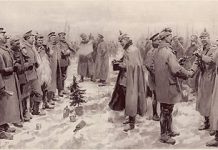The letter of St. Paul to the Romans uses the same basic structure found in his other letters. It features one important aspect of the mystery of Christ (chapters 5-11) and brings out its implications for Christian life, morality, and spirituality. In this case, the focus is on Christ as enacting the new and eternal covenant in His blood. The early parts of Romans (chapters 1-4) show our desperate need for Christ while the final portions (chapter 12-16) set forth the implications of this covenant for faith, conduct, and prayer.
The Background: The Covenant
There is no more basic theological idea in the pages of Scripture than the covenant. Even when we speak of the Bible as consisting of the Old Testament and the New Testament, we are using this central notion, for the term “testament” is one that derives from the Latin term testamentum as a translation of the Greek word syntheke and the Hebrew word berith. In modern languages like English, the distinction between words “testament” (as in “last will and testament”) and “covenant” (as a sacred compact) could conceal the unified idea suggested by the biblical terms.
The truth of the matter, however, comes clear when we realize that the reason why we use the phrase “New Testament” to designate the collection of the Gospels, Acts, the various Letters, and the book of Revelation is that they concern the new and eternal covenant made by Christ. Similarly, the reason for using the phrase “Old Testament” of the collection of the books that make up the Torah, the prophets, and the other writings such as the historical books, the psalms, and the sapiential books is that they concern the series of covenants that preceded the new and eternal covenant in Christ.1
The better to appreciate the Christological emphasis of Romans, it may be helpful to call to mind briefly the series of covenants that God created. In the garden of Eden God made a covenant with Adam and Eve that permitted them to eat the fruit of any of the trees in the garden except the tree of the knowledge of good and evil (Genesis 2:16-17). When they yielded to Satan’s temptation by eating that fruit and thus claiming the divine prerogative of determining what is good and what is evil, they suffered the penalty for their disobedience by expulsion from the garden. The effects of their sin afflicted not only Adam and Eve but the entirety of the human race that descends from them, including the need for wearying labor and for pain in childbirth (Genesis 3:16-19).
After the flood, God not only arranges to repopulate the earth through the offspring of Noah but also creates a second covenant that softens the stipulations of the first. There remains the need for each person to face a moral reckoning with God, precisely because of God’s special love for human beings as made in His own image (Genesis 9:6). The rainbow that God designed to appear in the clouds will serve as a reminder of this new covenant, for God promised never again to destroy the world by flood (Genesis 9:8-17). Instead, He will rain upon the just and the unjust alike – a symbolic way of expressing that in His own time God will call both the good and the evil to account but that no longer will there always be an immediate punishment for wickedness as there was with Adam and Eve or with Cain when he murdered Abel. Jesus alludes to this change in the covenant within the Sermon on the Mount (Matthew 5:45).
It is significant for our understanding of Romans to appreciate that these first two instances of the covenant concern the whole human race. God then undertakes a special relationship with His Chosen People in the covenant made with the childless Abram. God promises not only descendants as numerous as the stars in the sky but a special land in which to freely worship the Lord alone (Genesis 15: 1-11). As a sign of this covenant God changes his name to Abraham (“father of the many people”) and specifies the requirement of circumcision (Genesis 17: 1-14). The remainder of the story of the patriarchs recounts the protection and the blessings that God brings on Abraham and his descendants until the moment when it is time to bring the Chosen People to the Promised Land (as foretold to Abraham in a dream at Genesis 15:12-16).
There is good reason to take the fourth covenant mentioned in the Old Testament, the one that God makes with Moses, as the paradigmatic case, if only for the extensive way in which it is recorded in Exodus and Deuteronomy. As we will see below, the very structure of the letter to the Romans reflects some of the structure of the Mosaic covenant.
As scholars have often noted,2 the form that the bible uses to describe this covenant recapitulates the standard structure found in suzerainty treaties between a lord and his vassals in the ancient Near East: an identification of the parties to the treaty, a recitation of the history of the relationship between these parties, a formal statement of the stipulations that will govern the relationship, the benefits that will come from observance of the treaty, the consequences that will follow from its violation, and the oaths sworn before some higher authority.
In both Exodus (20: 1-17) and Deuteronomy (5:1-21) the basic pattern typical of such suzerainty treaties is used for recording the enactment of the Mosaic covenant, except for the final part. There is, after all, no higher authority than God before whom the Lord could possibly swear. What we do find are clear statements about the parties (the Lord and Israel), a rehearsal of their relationship (with an emphasis on the deliverance from servitude in Egypt), the stipulations (the ten commandments), the benefits ( the blessings that will follow to the thousandth generation for those who keep the commandments), and the consequences (the burdens that will afflict the children of those who sin).
The third of the covenants made with Israel and the fifth of those mentioned in the Old Testament is the one made with David (2 Samuel 7: 1-17). It comes when God had already acceded to the plea of His people to have Saul for their king and when Saul’s successor, David, could finally rest from his enemies. In response to David’s plan to build a temple to house the ark of God, the Lord revealed a message for David through the prophet Nathan that his successor (Solomon) would build the temple but that He would secure the kingdom by forever ensuring that a descendant of David would reign upon the throne (e.g., Ps 18:2).
Just as sinfulness broke the original covenant and led to God’s gracious enactment of a covenant with Noah, so too persistent sinfulness brought about the consequences for violation of the covenants that God had made with Abraham, Moses, and David. After the division of the monarchy into the northern kingdom of Israel and the southern kingdom of Judah, many of the kings proved sinful and rebellious against the Lord. The Assyrian invasion in 721 B.C. ended the royal line in Israel and the Babylonian captivity that began in 587/586 B.C. brought its end for Judah.
The Lord, however, remained faithful to what His covenants. In accord with the promises of a new covenant that He issued with Isaiah (e.g., 54:10) and Jeremiah (31: 31-34), God sent His Eternal Son to become incarnate of the Virgin Mary: Jesus Christ. The genealogies of Matthew (1: 1-17) and Luke (3:23-38) make a point of showing the place of David in the ancestors of Joseph, the foster-father of Jesus. Anointed the Messiah, Jesus does the royal deed of dying for the redemption of His people and of all humanity, and thus enacts the promise associated with the throne of David, a promise that had long been thought to have been forgotten when the line of kings was broken at the time of the Babylonian captivity.3 It is with a prominent reference to David that St. Paul’s letter to the Romans begins (1:3).
Romans on the Need for a New Covenant
After a salutation to the Christians of Rome (1:1-7) and a prayer of thanksgiving for their faith (1:8-15), St. Paul devotes four chapters to the power of God to take up the desperate situation of humanity in general and of Israel in particular and to bring about salvation through the new covenant initiated by the sacrifice of Christ. This section of the text plays a role comparable to the first two sections of the Deuteronomic covenant: the identification of the parties and the history of their relationship.
St. Paul’s argument in these chapters serves to prepare for his assertion of the necessity for faith in Christ. In his view, divine judgment would be righteous in condemning both Jews and Greeks for their failures to live in accord with what God has given them to know about His will. The Jews have special access to the will of God through the special covenants He made with Abraham, Moses, and David. The “Greeks” to whom St. Paul refers in this letter are not presumably just those people who live in Greece or who speak in the Greek tongue but all of humanity insofar as it still lives under the covenants made with Adam and Noah.
St. Paul’s reason for holding even those who have not enjoyed the benefit of revelation liable to divine judgment is his conviction that what can be known about the true God is evident from His creation. In phrases that resemble chapter thirteen of the Wisdom of Solomon, St. Paul takes those who worship nature or idols to task for the senseless nature of their worship and for embracing degenerate forms of morality (1:18-32).
In the course of inveighing against any form of hypocrisy, he interestingly grants that God will give a just reward to those who succeed in acting according to the lights they have been given: “[God] will render to every man according to his works: to those who by patience in well-doing seek for glory and honor and immortality, he will give eternal life” (2:6-7).
Those who have received the benefit of divine revelation of the Law and yet who have sinned will be judged by the Law. One cannot expect to be saved merely by having an expertise in the Law that makes one capable of teaching it to others (2:21) or by one’s membership in the Chosen People through circumcision (2:25). For St. Paul, the advantages of having divine revelation are considerable, especially through the witness that the scriptures give to Christ even before his coming (3:21), but insofar as one sins, there is no distinction between Jew and Greek. What is needed is faith in Christ Jesus who made the new and eternal covenant by His blood (3:25).
For St. Paul, Abraham’s faith illustrates this point (4:1-25). It was not any of his deeds that made him righteous, nor his circumcision, for his actions only followed his profession of faith. The letter stresses that all the covenant-promises Abraham received depended on the faith that he placed in God, and that God made someone as good as dead by his age and childlessness alive again and the father of countless descendants. Like the way that St. John the Baptist challenged the Pharisees who came out to the desert (Mt 3:8-9), St. Paul challenges his reader not to rest content with being descendants of Abraham but to follow his example by making the act of faith themselves and by producing fruits worthy of repentance.
At the conclusion of the chapter St Paul points us to the act in which we must put faith in order to become participants in the Christian covenant: “That is why his faith was reckoned to him as righteousness. But the words ‘it was reckoned to him’ were written not for his sake alone, but for ours also. It will be reckoned to us who believe in him who was raised from the dead, Jesus our Lord, who was put to death for our trespasses and raised for our justification” (4:23-25).
The Christology of Romans
The middle section of this letter (chs. 5-11) provides a detailed account of Jesus Christ as the one who enacts the new and eternal covenant. Beyond the promissory character of previous covenants this covenant brings about the justification of believers, for the death of Jesus in time (“at the right time Christ died for the ungodly,” 5:6) is the redemption of believers of all times. What is required of us is faith in Him, and this faith is what justifies us – that is, it restores right relationship to God after the damage done by sin. “We have peace with God through our Lord Jesus Christ” (5:1) because while we were still God’s enemies “we were reconciled to God by the death of his Son” (5:10).
The inexhaustible richness of the mystery of Christ enables Paul to explore different facets in each of his letters. Where Ephesians stresses the headship of Christ over all creation and where Philippians concentrates on the way He pours himself out in complete humility for our sakes, Romans again and again stresses the Christ as making a definitive covenant that sets aright the relationship of humanity to God and permits each individual to be justified by placing faith in Him. From the obedience of such faith will come the works of charity that are the new commandments of this new covenant (chapters 12-16).
St. Paul’s vision of Christ as completing what was incomplete and sanctifying what was sinful about life under the initial covenants involves showing Christ as the new Adam (5:12–6:23). In this section the central notion is the punishment (death) incurred by the first Adam’s transgression of the original covenant. This penalty entered through the sin of one man and spread to all his descendants. By baptism into the new covenant we are receive a share in His death by going beneath the waters, and then a sacramental share in His resurrection when we rise up from them. This happens not by any merit of their own but as His free gift. If we retain the gift of divine life by living (6:12-14) in accord with the baptism that begins our restoration to friendship with God and our gradual sanctification (6:19), we will be given an abiding share in Christ’s life forever by a resurrection like His (6:5, 6:23).
The new and eternal covenant in Christ is at once something that perfects and sanctifies the older covenants and something that is truly new and eternal. St. Paul shows this in detail by his analogy with re-marriage after the death of a spouse and by his treatment of our life in the Spirit (chapters 7-8). So long as both husband and wife are alive, the law demands their fidelity and forbids union with anyone else as adultery, but after the death of one’s spouse one is free to marry someone else. The words by which he draws out the point of the analogy are striking: “Likewise, my brethren, you have died to the Law through the body of Christ, so that you may belong to another, to Him who has been raised from the dead in order that we may bear fruit for God” (7:4). To say this is to show the regard of the new and eternal covenant for the previous covenant, as when he writes: “So, the law is holy, and the commandment is holy and just and good” (7:12). But our entrance into the new covenant us to the new life of the Spirit (7:6).
This new life in the Spirit does not mean that the commandments of the Law do not apply. Rather it is a life marked by the sort of freedom that can come from practicing a willing obedience in faith to all that the commandments require and in addition being deeply alert to the stirrings and promptings of the Holy Spirit (8:1-17). It is the cultivation of this obedience of faith that Paul takes to be central to his own apostleship (1:5). The effects of the sanctification process upon us that participation in this covenant are numerous, including the help of the Spirit in our weakness so that the Spirit will guide us when we find ourselves not knowing how to pray as we ought to do (9:26) and that Christ will intercede for us from His seat at the right hand of the Father even when we are experiencing persecution or peril (9:34-35).
As a kind of coda for the entire section on the Christian covenant, the final segment (chapters 9-11) presents St. Paul’s understanding of the identity of the true Israel. Mindful that it was Israel to whom the promises of the covenant were made, Paul argues that the true Israel is not the set of those who descended from ancient Israel in the flesh but the people who have received the fullness of what God long promised. What God promised was the gift of His Son as the Messiah and Redeemer, and so it is those who have come to believe in Christ (and thus including many Gentiles) who are the true Israel. St. Paul’s heart aches for his brethren (9:1-5), but he insists that coming to have possession of what was promised is not a matter of justice or injustice but entirely a matter of the mercy and divine gift (9:6-18).
The implication of this insight about the true Israel is that salvation is open to everyone. What is required is the sort of life and love that follow from a confession that Jesus is Lord and belief that God raised him from the dead, and this is possible for anyone: “For there is no distinction between Jew and Greek; the same Lord is Lord of all and bestows his riches upon all who fall upon him. For everyone who calls upon the name of the Lord will be saved” (10:12-13). Amid St. Paul’s effort to explain that the salvation of the Gentiles has taken place in a way that resembles the grafting of wild olive shoots into the root of an olive tree (11:17), he also explains his hope that the branches native to that tree will someday be grafted back in (11:24). He puts this assertion explicitly in covenantal terms: “The Deliverer will come from Zion, he will banish ungodliness from Jacob, and this will be my covenant with them when I take away their sins” (11:26-27).
The Terms of the Covenant: Life, Morality, and Spirituality
Just as the Mosaic covenant includes a set of stipulations, so too the final chapters of the letter to the Romans (chapters 12:1–15:13) before attending to such epistolary matters as travel plans (15:22-33), personal greetings and instructions for the community (16:1-24), and a special blessing (16:25-27).
The content of the normative part of this letter is what we would expect from knowing the teachings of Christ recorded in the Gospels. Like the first tablet of the Old Law and the first commandment of the New, the doctrine here begins with an instruction on true worship. Saint Paul urges us to present our bodies as a living sacrifice, holy and acceptable to God, along with minds that resist conformity to this world and that are trained instead on doing the will of God (12:1-2). To accomplish this he urges the cultivation of a profound humility and a readiness to use the particular gifts that each of us have received for service in the one body of Christ that is the Church (12:3-8).
Like the second tablet of the Old Law and the second commandment of the New, what follows spells out the injunction of Christ not only by quoting a number of the commandments (13:9-10) but also by providing examples of how we are to love our neighbors as ourselves: “Let love be genuine; hate what is evil, hold fast to what is good, love one another with brotherly affection; outdo one another in showing honor” (12:9-10). The list that follows is lengthy but practical: bless those who persecute you, repay no one evil for evil, live peaceably with everyone so far as it is possible, and leave vengeance to God. Presumably relying on the directives of Jesus about rendering to Caesar what is Caesar’s and to God what is God’s, St. Paul includes a section on the respect and obedience that Christians are to render to worldly authorities (13:1-7). Toward the end of the section there is a brief treatment about such disciplinary and ascetical matters as eating and fasting, couched within a directive not to pass judgment on one another in such questions (14:1-12) and a correlative directive to err on the side of charity by self-denial rather than ever to place an obstacle or stumbling-block in another’s way (14:13-23).
Father Joseph W. Koterski, S.J. is a Professor in the Philosophy Department at Fordham University, in the Bronx, New York.
1 See Joseph Cardinal Ratzinger, Many Religions – One Covenant: Israel, the Church, and the World. Translated by Graham Harrison. San Francisco CA: Ignatius Press, 1999. German original: Die Vielfalt der Religionen und der Eine Bund (Verlag Urfeld GmbH, Hagen, 1998).
2 For instance, Richard J. Clifford, S.J., Deuteronomy, with an excursus on covenant and law (Wilmington DE: Michael Glazier, 1982).
3 See my “Carpaccio’s Mysterious Painting,” Fellowship of Catholic Scholars Quarterly 38/ 3-4 (Fall/Winter 2015): 5-10.











